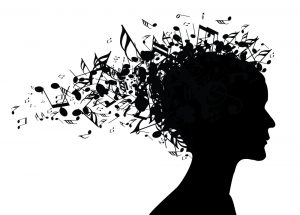Music in your head
 Before modern neuroimaging techniques were developed, researchers studied the musical abilities of the brain, observing patients (including famous composers) with various disruptions in their activity due to injury or stroke. So, in 1933, the French composer Maurice Ravel developed symptoms of local brain degeneration, a disease that is accompanied by atrophy of certain sections of brain tissue. The composer’s mental abilities did not suffer: he remembered his old works and played scales well. But he could no longer compose music. Speaking about his alleged opera “Joan of Arc”, Ravel confessed: “Opera is in my head, I hear it, but I will never write it. It’s over. I am no longer able to compose music.” He died four years after an unsuccessful neurosurgical operation. The history of his illness gave rise to the idea among scientists that the brain is devoid of a specialized music center.
Before modern neuroimaging techniques were developed, researchers studied the musical abilities of the brain, observing patients (including famous composers) with various disruptions in their activity due to injury or stroke. So, in 1933, the French composer Maurice Ravel developed symptoms of local brain degeneration, a disease that is accompanied by atrophy of certain sections of brain tissue. The composer’s mental abilities did not suffer: he remembered his old works and played scales well. But he could no longer compose music. Speaking about his alleged opera “Joan of Arc”, Ravel confessed: “Opera is in my head, I hear it, but I will never write it. It’s over. I am no longer able to compose music.” He died four years after an unsuccessful neurosurgical operation. The history of his illness gave rise to the idea among scientists that the brain is devoid of a specialized music center.
This hypothesis was confirmed by the case of another famous musician. After the stroke suffered in 1953, the Russian composer Vissarion Shebalin was paralyzed and stopped understanding speech, but until his death, which followed 10 years later, he retained the ability to compose. Thus, the assumption of independent processing of musical and speech information turned out to be true. However, later studies have made adjustments related to two common features of music and language: both mental functions are a means of communication and have a syntax – a set of rules that determine the proper combination of elements (notes and words, respectively). According to Aniruddh D. Patel from the Institute of Neuroscience in San Diego, studies conducted by neuroimaging methods indicate that the correct design of linguistic and musical syntaxes is provided by the frontal (frontal) cortex, and other parts of the brain are responsible for processing related components of language and music.
We also got a complete picture of how the brain reacts to music. The auditory system, like all other sensory systems of the body, has a hierarchical organization. It consists of a chain of centers that process the nerve signals that go from the ear to the highest part of the auditory analyzer – the auditory cortex. The processing of sounds (for example, musical tones) begins in the inner ear (cochlea), which sorts out complex sounds (made, for example, by violin) into constituent elementary frequencies. Then, through the fibers of the auditory nerve, which are tuned to different frequencies, the cochlea sends information in the form of a sequence of neural discharges (pulses) to the brain. As a result, they reach the auditory cortex in the temporal lobes of the brain, where each cell responds to the sounds of a certain frequency. The frequency tuning curves of neighboring cells overlap, i.e. there are no gaps between them, and a frequency map of sounds is formed on the surface of the auditory cortex.
Each brain cell responds to a specific pitch (frequency) of sound (a). When a tone acquires special significance for an animal, the initial tuning of the cells changes (b). The result is a larger brain area (s).
Brain reactions to music are much more complicated. Music consists of a sequence of notes and rhythm, and its perception depends on the ability of the brain to sense the relationship between sounds. Many of its areas are involved in the processing of various components of music. Take, for example, a tone that includes both frequency components and sound volume. At one time, researchers believed that cells tuned to a certain frequency, “hearing” it, always react the same way.
But in the late 1980s. Thomas M. McKenna and the author of this article questioned this submission. In those years, we studied the reactions of the brain to sound contours — complexes of sounds of increasing or decreasing pitch, which form the basis of any melody. We constructed melodies consisting of different contours using five identical tones, and then recorded the responses of single neurons of the auditory cortex of the cat. It was found that cell responses (the number of digits) depended on the position of a given tone in a melody: neurons could discharge more intensively if other colors preceded a tone than when it was first in a melody. In addition, the cells reacted differently to the same tone, depending on whether it was part of an ascending circuit (in which the pitch of the sounds increased) or descending. This indicates the great value of the melody pattern: processing information in the auditory system is significantly different from simply relaying the sounds in the phone or stereo system.
Brain reactions to music also depend on the experience and preparedness of the listener.



